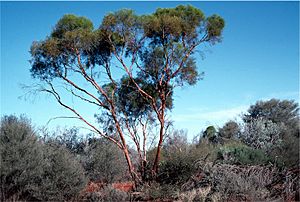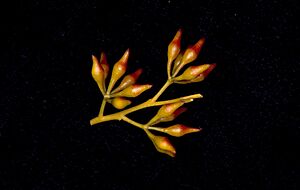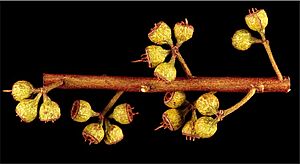Die Hardy mallee facts for kids
Quick facts for kids Die Hardy mallee |
|
|---|---|
 |
|
| Eucalyptus formanii in the Die Hardy Range | |
| Conservation status | |
| Scientific classification | |
| Genus: |
Eucalyptus
|
| Species: |
formanii
|
The Die Hardy mallee (scientific name: Eucalyptus formanii) is a special type of tree or shrub. It is also known as Forman's mallee or feather gum. This plant is only found in Western Australia. It has rough bark on its trunk and smooth bark higher up. Its leaves are long and thin. The flowers are creamy white and grow in groups. After flowering, it produces small, cup-shaped fruits.
Contents
What Does the Die Hardy Mallee Look Like?
The Die Hardy mallee can grow up to 10 m (33 ft) (about 33 feet) tall. It often grows as a "mallee," which means it has many stems coming from a woody base called a lignotuber. This helps it regrow after fires.
Bark and Leaves
The bark on the lower part of the trunk is rough and grey. It can be flaky or fibrous. Higher up, the bark is smooth and can be creamy brown or pinkish-grey. This smooth bark peels off in long strips.
Young plants have long, narrow leaves. These leaves are about 20–45 mm (0.79–1.77 in) long and 2–4 mm (0.079–0.157 in) wide. Adult leaves are also long and thin, usually 35–95 mm (1.4–3.7 in) long and 2–5 mm (0.079–0.197 in) wide. They stand upright and are shiny green on both sides.
Flowers and Fruit
The flower buds grow in groups of seven or nine. They are found where the leaves meet the stem. Each group of buds sits on a small stalk about 4–10 mm (0.16–0.39 in) long. The buds themselves are oval or spindle-shaped. They are about 4–7 mm (0.16–0.28 in) long.
The Die Hardy mallee blooms between December and April. Its flowers are a lovely creamy white color. After the flowers, the plant produces woody fruits. These fruits are shaped like a cup or half a sphere. They are about 3–4 mm (0.12–0.16 in) long and 4–5 mm (0.16–0.20 in) wide.
How It Got Its Name
The Eucalyptus formanii was first officially described in 1943. A botanist named Charles Gardner gave it its scientific name.
Honoring a Geologist
The plant was named after Francis Gloster Forman. He was a government geologist in Western Australia. Mr. Forman found the first samples of this plant near the Die Hardy Range. He then brought them to Charles Gardner.
About the Die Hardy Range
The Die Hardy Ranges are a group of hills in Western Australia. They are located north of Mount Jackson. This area used to have gold mines. In 2010, the Die Hardy Range became a nature reserve. This means it is a protected area for plants and animals.
Where the Die Hardy Mallee Grows
The Die Hardy mallee is found in specific areas of Western Australia. It grows on ironstone slopes north of Bullfinch. You can find it in sandy soils.
Its Home Environment
This tree is part of low woodland areas. These woodlands cover a large part of the Mount Manning Nature Reserve. The Die Hardy mallee grows on flat sandy plains in wide valleys. The soil there is often sandy loam.
These woodlands usually have trees about 10 m (33 ft) tall. Below them, there are other plants like Triodia rigidissima, which is a type of grass. There are also many different shrubs. Some of these include Grevillea acuaria, Bossiaea walkeri, and various types of Eremophila.
Protecting the Die Hardy Mallee
The Government of Western Australia's Department of Parks and Wildlife has given this eucalypt a special status. It is classified as "Priority Four". This means it is rare or almost threatened. It needs to be watched and protected so it doesn't become endangered.
Why It's Special
The Die Hardy mallee has fine, crowded leaves. It also has a special ability to regrow from its base (coppicing). These features make it a beautiful plant that could be used in gardens.




